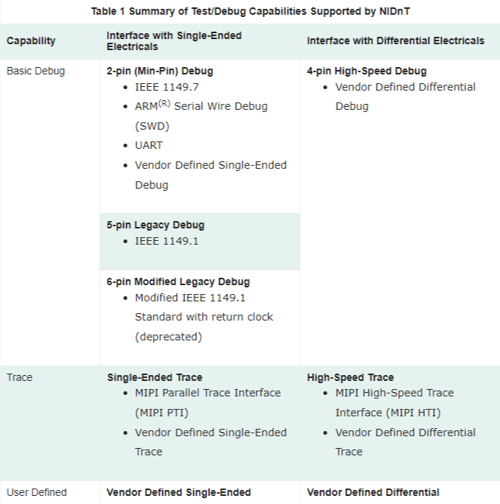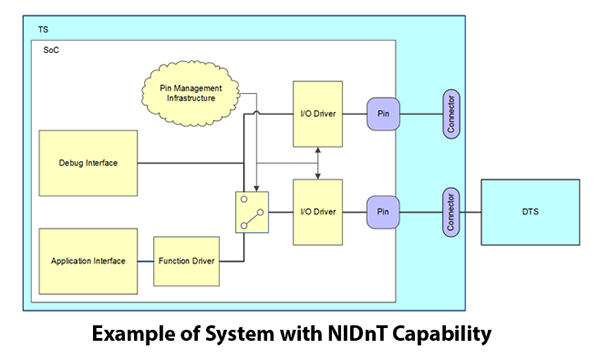MIPI NIDnT™
MIPI Narrow Interface for Debug and Test
.png?width=1200&height=600&name=Banner%20Images%20-%20MIPI%20(26).png)
Developed by: Debug Working Group
Using available ports on a device for end-product testing
Quick Facts
-
Fundamental Feature
A standardized way to use functional interfaces for debug and test procedures
-
Functional Interfaces Supported
USB Type-CTM

USB 2.0 Micro-B/-ABTM
microSDTM
HDMITM
DisplayPortTM -
Use Cases
- Debug and test throughout the development life cycle
- System-on-chip testing
- Testing devices enclosed in a product's final form factor
- Testing small, very thin devices
- Creating generic or company-specific testing tools
Get the Specification
-
Current Version
MIPI NIDnT℠ v1.2.1 (June 2022)
Member version | Public version
| Public version 
-
Previous Versions
MIPI NIDnT℠ v1.2 (December 2017)
Member version | Request public versionAll NIDnT versions are available to MIPI members on the member website (Causeway).
Overview
General Info
-
Overview
MIPI Narrow Interface for Debug and TestSM (MIPI NIDnTSM) defines a standardized way to use functional ports on a device for debug and test procedures. The specification makes it easier for developers to identify problems in complex designs to ensure high-quality products. It also reduces development costs because it alleviates the need for expensive, proprietary testing tools.
All MIPI debug and trace specifications, including MIPI NIDnT, are available for download and use by the public and the open source community. Members of the MIPI Alliance enjoy benefits including access to relevant licenses and opportunities to participate in development activities, interoperability workshops and other events.
For information about MIPI Alliance membership, visit Join MIPI.
-
Key Features
A key feature of MIPI NIDnT v1.2 is an innovative use of USB Type-C v1.2 "alternate modes" to facilitate debug and test over USB Type-C pins. The capability provides conveniences to developers in many device segments because USB Type-C is gaining popularity as a robust connector for small, thin devices such as smartphones, tablets and laptops as well as IoT, augmented reality and virtual reality products.
MIPI NIDnT v1.2 is versatile, offering designers the flexibility to perform debug and test over other interfaces that are widely used in mobile and mobile-influenced designs. Interfaces supported by the specification include USB 2.0 Micro-B/-AB, microSD, HDMI and DisplayPort.
-
Benefits
Developers can benefit from MIPI NIDnT v1.2 conveniences throughout the development lifecycle. It supports debugging during the system design process, when space is not available on a board for a dedicated debug connector. It can also be used after products are on the market, when testing requires access to components that are enclosed within a sealed device.
Typical organizations that adopt MIPI NIDnT v1.2 include companies that want to build debug and testing tools for their own internal processes as well as companies that develop generic testing tools for SOC manufacturers, board developers and OEMs.
MIPI NIDnT v1.2 and the MIPI Discovery and Configuration Specification for Narrow Interface for Debug and Test v1.0SM (MIPI DisCo for NIDnT v1.0) complement each other. This is a standardized software tool that makes it possible for test device software to easily discover and configure the hardware debug and test capabilities enabled by MIPI NIDnT.
-
Diagrams and Tables
Debug Capabilities per Adjacent Industries
(best viewed on desktop)
Summary of Test/Debug Capabilities Supported by NIDnT
(click to enlarge)
Example of System with NIDnT Capability
(click to enlarge)
Industries










